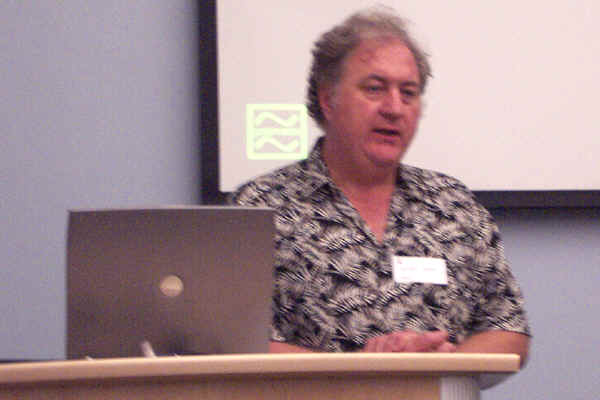At AES San Francisco's August meeting, David Josephson spoke about
multiple capsule, variable pattern microphones, and their use in intensity
stereo and surround pickups.
The meeting was held at Plantronics Corporation, in Santa Cruz, California. Over fifty people attended.
Mr. Josephson is founder of Josephson Engineering, a microphone maker
in Santa Cruz. He holds three patents in directional
microphone design.

Mr. Josephson gave a brief overview of microphone pattern control
techniques. He discussed basic principles of sound localization.
Sound localization is possible because of a variety of cues, including
intensity, time of arrival, onset, and frequency response.
One way our ears can localize sounds is through variations in high
frequency response, due to head blocking. Sounds arriving from the
right of the head have attenuated high frequencies in the left ear,
compared to the right.
The remainder of the meeting focused on intensity stereo recording using
multiple variants of the MS technique. An infinite variety of
directional patterns may be derived from three signals: one pressure
(omni) transducer and two gradient (figure-8) transducers at right
angles. This group of signals may be called "native B format" in
reference to the derived B format of the Ambisonics and the Soundfield
microphone. The Z or elevation signal is omitted. Josephson
Engineering's C700S microphone, which was demonstrated at the close of
the meeting, is an example of a microphone with three capsules as
described.
One capsule is omni directional, facing forward, another is a figure
of eight, facing front/back. The third is a figure of eight, facing
left/right. The signals from the capsules are W, X, and Y, respectively.
Raw "W," "X," and "Y" signals can be recorded
directly, allowing
pattern selection at mixdown.
All the channels needed for stereo, center-channel stereo, or surround
(both 5.1 and 7.1), can be derived by adjusting mixer ratios.
AESSF's August meeting was followed by a lively question and answer
session. A recording of a small ensemble, from a C700S microphone, was
demonstrated.
by Paul Howard
